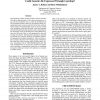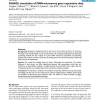292 search results - page 12 / 59 » On the Expression of Interaction Properties within an Intera... |
AAAI
2000
13 years 9 months ago
2000
Self-organizing models develop realistic cortical structures when given approximations of the visual environment as input, and are an effective way to model the development of fac...
BMCBI
2006
13 years 8 months ago
2006
Background: Simulation of DNA-microarray data serves at least three purposes: (i) optimizing the design of an intended DNA microarray experiment, (ii) comparing existing pre-proce...
COOPIS
2000
IEEE
14 years 1 days ago
2000
IEEE
The focus of traditional workflow management systems is on control flow within one process definition, that describes how a single case (i.e., workflow instance) is handled in isol...
SPIN
2005
Springer
14 years 1 months ago
2005
Springer
We describe a method for the specification and verification of the dynamic behaviour of component systems. Building applications using a component framework allows the developers...
NETWORKING
2011
12 years 11 months ago
2011
Abstract. In this paper we introduce Spatio-TEmporal Parametric Stepping (STEPS) - a simple parametric mobility model which can cover a ectrum of human mobility patterns. STEPS mak...


